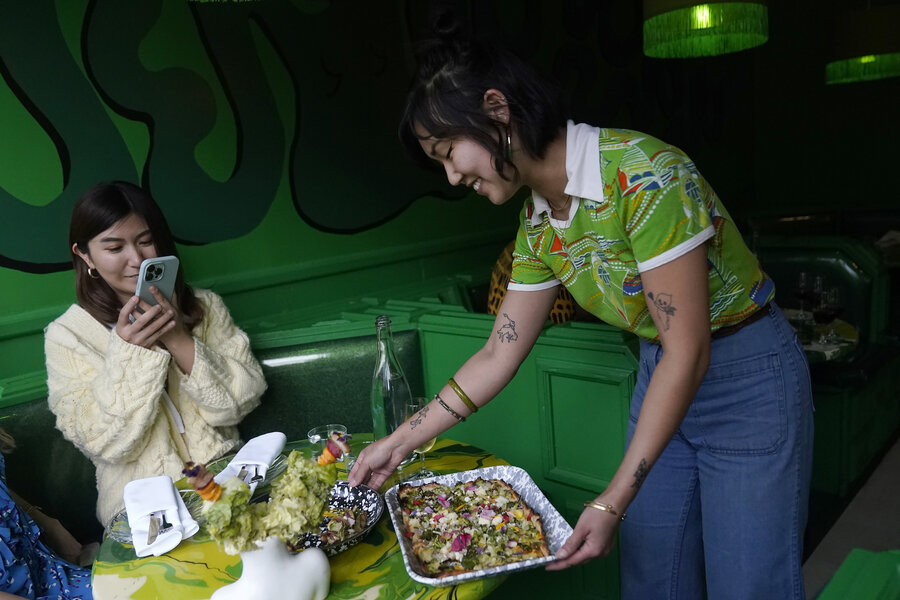Upcycling movement: How US chefs transform waste into meals
Loading...
| Los Gatos, Calif.
At Tyler Malek’s ice cream parlors, one cook’s trash is another chef’s frosty treat.
The head ice cream maker at the Portland, Oregon-based Salt & Straw uses the whey leftover from yogurt makers in upstate New York to make his lemon curd flavor. For chocolate barley milk, he mixes in the remnants of rice and grains from beer brewing to give it a light and creamy taste.
“Instead of calling this food waste, we need to call it wasted food and start decreasing how much wasting we’re doing,” Mr. Malek said.
Mr. Malek’s ice cream chain is among those at the forefront of the upcycling movement, the process of creating high-quality products from leftover food. Mr. Malek’s shops from the Pacific Northwest to Miami now feature flavors like “Cacao Pulp & Chocolate Stracciatella Gelato,” which is made from leftover cacao pulp from chocolate production that otherwise would have gone to waste.
It’s a trend gaining ground as consumers spend more time reading packaging labels and menu ingredients to learn where their food comes from and how it affects the environment. More than 35 million tons of food are wasted every year in the United States – about 40% of the country’s food production – costing the national economy more than $200 billion, according to the Upcycled Food Association.
Upcycled food is becoming increasingly common in cake mixes and veggie chips at natural grocery stores. Ingredients include fruits and vegetables from farms nationwide that are perfectly edible but often rejected by restaurants and grocery stores because of their shape or color, like white strawberries, wilted greens, and ugly mushrooms.
The Upcycled Food Association, which will celebrate World Upcycling Day on Saturday, issues an official “Upcycling Certified” seal to qualifying products. These seals, which adorn the new Salt & Straw upcycled flavors, raise awareness with consumers that the company making the food used such ingredients.
The association initially certified about 30 products in 2021 and now has 450 carrying the label.
“A lot of the food that is uneaten or thrown away in our supply chain is actually due to archaic cosmetic standards or sort of perceptions that what we think is edible or quality food,” said Angie Crone, the association’s chief executive. “So this is a mark that you can see on the products wherever you go shopping, to be able to understand how that company is reducing food waste in their supply chain.”
The association’s seal also is featured on all products made by Renewal Mill, an Oakland-based company turning byproducts from plant-based milk into pantry stables like baking flour to reduce waste at the manufacturing level.
“Our first product is the pulp leftover from making soy milk. We turn that into a high fiber gluten-free flour called okara flour,” co-founder Caroline Cotto said. “And then we use that flour to make things like baking mixes and ready-to-eat cookies.”
The company’s okara flour is featured in Salt & Straw’s new “Salted Caramel & Okara Cupcakes” flavor.
The movement isn’t confined to recycled products found in a trendy ice cream store, farmers market, or natural grocery. In San Francisco, a restaurant serving pizza and wine focuses on upcycled ingredients such as ugly mushrooms, misshapen peppers, and discolored tomatoes, as well as offcuts of meat for menu stars like beef heart meatballs.
“I think so many people think about dumpster diving or using rotten ingredients, but we have this wildly overproductive food system that accounts for a ton of waste,” said Kayla Abe, co-owner of Shuggie’s Trash Pie. “Some people might not read that it’s a beef heart meatball and they just might see meatball. They order it and they’re like, that was the best meatball I’ve ever had in my life.”
This story was reported by The Associated Press.







